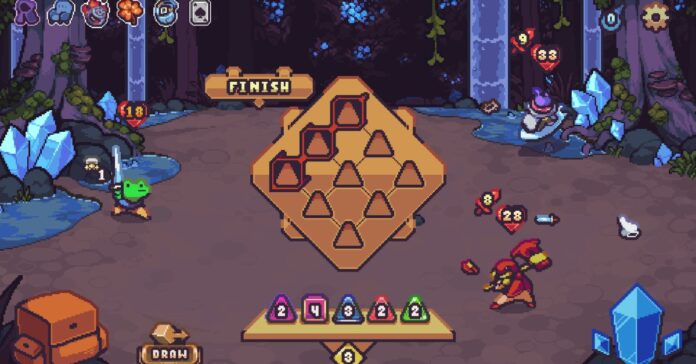Die in the Dungeon is a new roguelike deckbuilder that pulls some ideas from Slay the Spire, one of my favorite games, but adds some dice-based twists that have me hooked.
In Dungeon, your goal is to survive through progressively harder maps of enemies by building a deck — but instead of collecting cards, you’re collecting dice. During every hand, you have a certain amount of energy you can use to play your dice. And since you can see every move your enemies will make on the next turn, the game is mostly about strategizing how to attack the baddies while defending yourself.
If you’ve played Slay, this setup should feel pretty familiar.
But Dungeon’s clever twist is in how you play. At the beginning of each turn, the game will roll dice from your deck into your hand, and you’ll need to decide how to play them on a board. Each die has a value, so the higher the value, the more damage you’ll deal or block you’ll set up to defend yourself.
There are multiple types of dice, including attack dice, block dice, healing dice, and dice that can boost the value of other dice on the board. Each one costs a certain amount of energy to play, which puts limits on how many you can use in one turn. And sometimes, enemies will add modifiers to spots on the board.
That all means you’ll have to think a lot about how and where you play your dice on the board. Do you go all in with attack dice to take a big chunk of an enemy’s health, but leave yourself vulnerable to attacks? Do you spend some energy on a boost block to give yourself more defense at the cost of being able to use a health dice? Just about every turn in Dungeon requires some strategic thinking.
The intensity of the strategy makes the Slay-esque trappings something of a comfort. I find Dungeon to be very hard; the enemies can really pack a punch if you’re caught off guard, and I haven’t been able to get past the bosses of the game’s first two worlds unless I have a clear idea of what my build is.
But I already understand how to think about building a deck from many hours of Slay. I’ve called on a lot of those skills to make things easier over the 10-plus hours I’ve put into Dungeon so far — and to accomplish my one and only cleared run.
While Slay is good at keeping things snappy with battles that are just long enough — I could often finish a run in around 45 minutes — runs in Dungeon can drag. Individual battles can take minutes on their own because of how much you might just sit and think. Loading screens that take five or more seconds add up over the course of a run. The dungeon maps also have a few too many spaces. My longer runs, where I’ve gotten to the third and final world, have taken nearly two hours.
Dungeon is launching in early access, though, so I’m hoping the rougher edges will get smoothed out over time. Even over the couple weeks I’ve been playing the game, there have been some welcome updates, like one that gives you coins if you choose to skip an end-of-battle reward. The game’s developers have posted a promising roadmap, too. That all makes me optimistic for Dungeon’s long-term future.
And its foundation is really strong. I’ve had a blast with Dungeon, despite its faults and me only having beaten the game with one of the three available characters so far. After I lose a run, I often mull over how I could have done things differently, and I’m usually eager to hop back in to roll the dice again.
I’ve been really looking forward to Slay the Spire 2, which is supposed to come out in early access this year. But I might have already scratched the deckbuilding itch with Die in the Dungeon.
Die in the Dungeon is now available in early access on Steam. You can try a version of it for free on itch.io.


